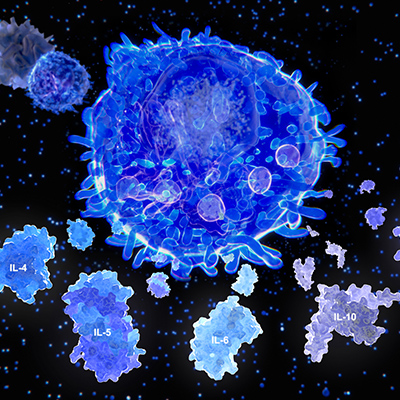June 2, 2021 -- The development process of immune cells important for establishing long-term immunity has been revealed through detailed single-cell techniques. A new study, published in the journal Science Immunology on May 28, examined extracted tonsils and lymph nodes to establish how human T follicular cells specialize in the body.
T follicular cells are a type of white blood cell mostly found in secondary lymphoid organs, such as the tonsils, spleen, and lymph nodes. They exist in helper and regulatory forms, and play an integral role in developing immunity against a disease either following infection or vaccination.
T follicular helper cells support B cells to produce antibodies against foreign pathogens and develop an immune memory to quickly respond to future infections. By contrast, T follicular regulatory cells help to suppress the production of autoantibodies -- antibodies that would attack the body's own cells.
T follicular cells need to interact with other immune system components, such as dendritic cells and B cells, in order to mature and specialize in their roles. This complex developmental environment makes it difficult to study the maturation process in laboratory assays. While these cells are well studied in mice, differences with the human immune system make it difficult to translate findings for medical research.
Most previous work on human T follicular cells was done with cells that circulate in the blood. However, this is insufficient to examine the entire maturation process without the mature cells that are found in the lymphoid tissue.
Maturation variation
In the new study, researchers led by Luís Graça, PhD, professor at the University of Lisbon, used a technique called single-cell RNA sequencing to compare T follicular cells, a type of lymphocyte, taken from samples of tonsils, lymph nodes, and blood. This technique identifies messenger RNA molecules produced by the cells to reveal which genes are active.
"To understand the power of this technology, we must note that all of our cells have the same genes," said Graça in a statement. "However, a cell like a lymphocyte uses a different combination of genes compared to a neuron. Thus, after vaccination, when a lymphocyte starts the process of controlling the production of antibodies, it will turn on some genes and turn off others. This is what we studied for hundreds of cells simultaneously."
The T follicular cells showed different levels of maturation in each of the sources, with the blood cells being the least mature and the tonsil cells being the most mature. The cells' patterns of gene activity revealed that blood and tissue T follicular regulatory cells represent two separate populations that split off as they mature from regulatory T cells. The immature T follicular regulatory cells in the blood did not appear to be the source of the more mature cells in the tissue.

A better understanding of how these immune cells behave could help to improve the generation of antibodies in the lymph nodes in response to vaccination or develop new treatments for autoimmune diseases.
"When the biological systems of our organism are not properly regulated, disease arises. It is the knowledge of the organism's regulation that allows [the correction of] these pathological situations, restoring the healthy balance of a well-regulated system," said Graça.
The tonsils used in the study were recovered from two healthy children who were having them removed by surgery. The lymph nodes and blood samples came from two kidney transplant recipients and two healthy volunteers, respectively.
Single-cell RNA sequencing offers scientists much deeper insights into how different cell types work in the body. The ability to analyze the total genetic activity, or transcriptome, builds on previous "omics" advances in genomics and proteomics that identify the different genes and proteins present in the cell, respectively.
"When the study started four years ago, we did not have the experimental tools needed and the advances in technology have been extraordinary. Using omics technology offered an incredible solution to this problem and we ended up using it," said Saumya Kumar, the first author of the study.
Do you have a unique perspective on your research related to immunology or cell biology? Contact the editor today to learn more.
Copyright © 2021 scienceboard.net







